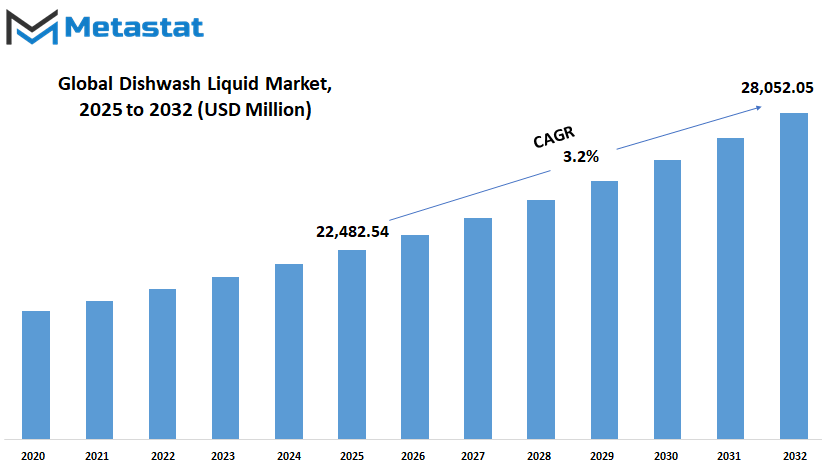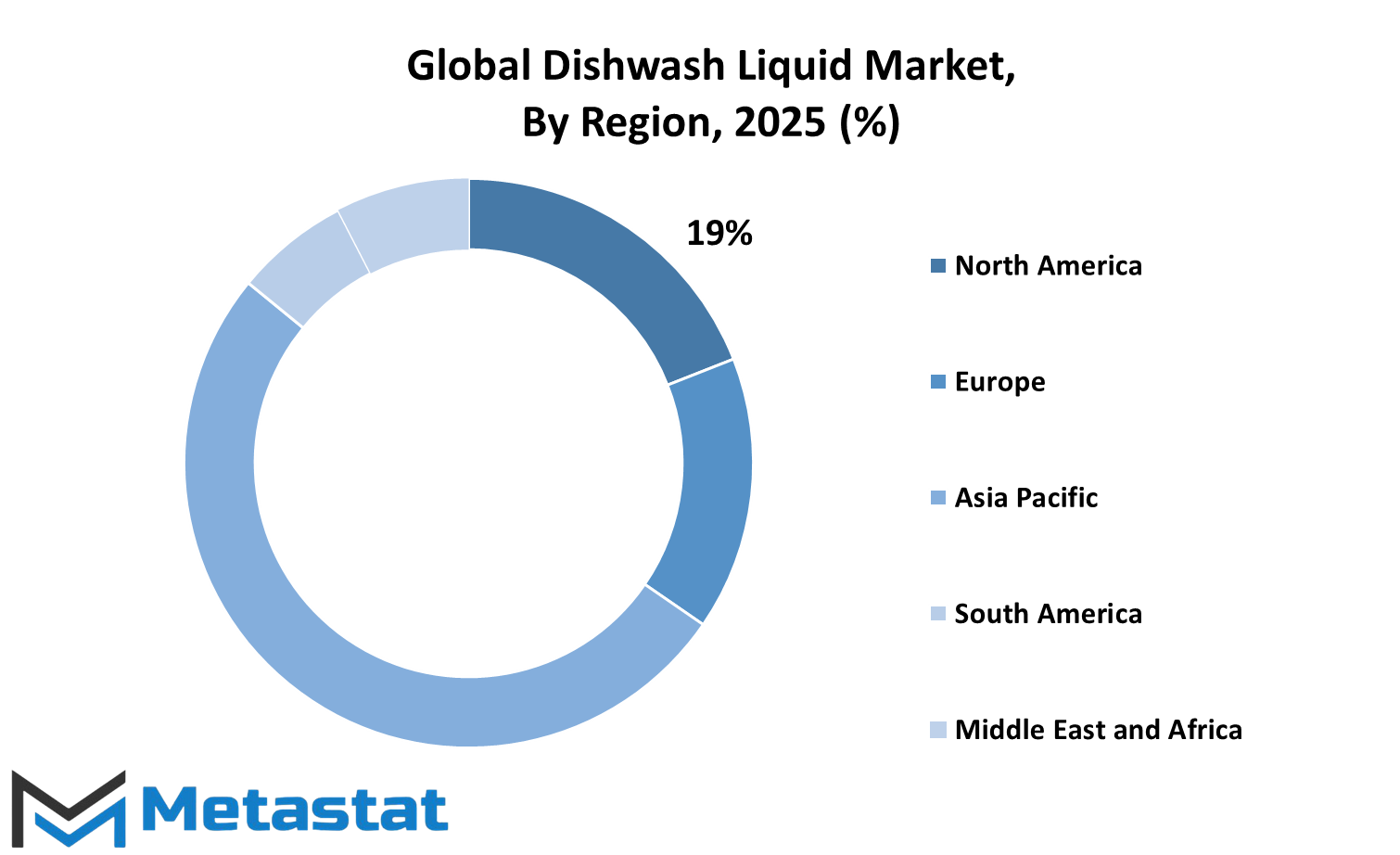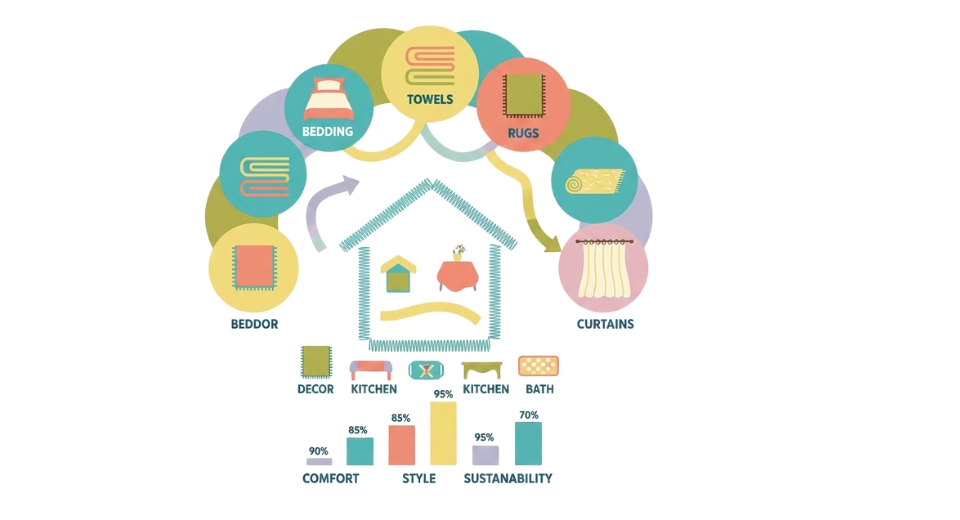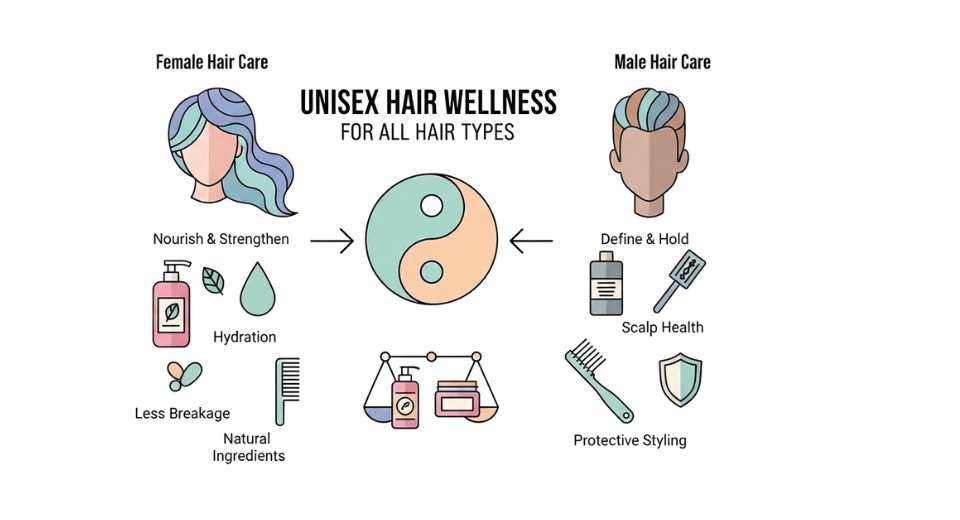MARKET OVERVIEW
The Global Dishwash Liquid market is an active and growing sector in the cleaning products industry. In this sense, consumers demand effective and environmentally friendly household and commercial cleaning solutions; hence, the evolution of dishwashing liquids is going to keep offering consumers new formulations and performance benefits. This market comprises a vast array of dishwashing liquids, ranging from basic detergents to premium formulations promising effective grease removal, pleasant fragrances, and even additional properties that care for the skin.
These are the most basic commodities to any household and also to restaurants, hotels, and other foodservice establishments where keeping clean and hygienic is synonymous with survival. The scope of the Global Dishwash Liquid market is not limited to residential use alone but extends to commercial sectors and institutional environments, such as cafeterias, hospitals, and catering services.
The focus is not only on cleaning power but also on environmental sustainability, safety, and convenience in use. The more environmentally conscious the consumers, the more they are likely to ask for alternatives. Companies will be pushed to design products that are biodegradable, chemical-free, and packed with recyclable material. This preference will give rise to a different market structure as regulations over chemicals become stringent across regions. The dishwashing liquid market will not be spared innovation mainly by technology advancement as it will be born with new formulas that ensure both efficiency in cleaning and being gentle on the hands and surfaces.
The future is organic and plant-based, which gives way to the differences and will allow brands to compete more within a very competitive space. The companies will develop more concentrated formulas that will minimize packaging waste while giving consumers better value for money. Manufacturers will also look into innovative packaging designs that are convenient, easy to use, and environmentally friendly. The development of the Global Dishwash Liquid market will also be influenced by an expansion of the distribution channels.
Online shopping platforms will be very important in determining consumer purchase behavior and several consumers will buy dishwashing liquids through e-commerce sites, which prove to offer a faster buying experience and a wider range of products. The increasing penetration of digital platforms will make the traditional players, such as supermarkets and convenience stores, indispensable for brands looking to penetrate larger markets, which are emerging today.
At the same time, the ongoing trends of health and hygiene will make sure that dishwashing liquids will continue to remain a cornerstone in both household and commercial cleaning routines. At such a time, where consumers are becoming conscious about bacteria, viruses, and allergens, the demand for superior hygiene out of dishwashing liquids will not cease to exist. Brands that guarantee deep cleaning while also being safe for nature and their health will be given their due prominence by consumers.
The global scope of the dishwashing liquid business would expose the business to diversified challenges and opportunities in different markets. North America, Europe, Asia Pacific, and the Middle East will have market differences in terms of local consumer preferences, regional regulations, and the related economic drivers. Developed economies will prefer premium brands while growing economies will increase the demand for a more cost-effective yet efficient dishwashing agents.
Global Dishwash Liquid would experience further diversification and growth over the years due to changed consumer behavior and a change in regulatory environment. Sustainability practices, new formulation concepts, and innovations in distribution techniques will drive this future of the market and keep both the leading as well as the emerging players very excited in terms of development opportunities.
Global Dishwash Liquid market is estimated to reach $28,052.05 Million by 2032; growing at a CAGR of 3.2% from 2025 to 2032.

GROWTH FACTORS
The Global Dishwash Liquid market is turning upward, largely as a result of many factors. As people increasingly value ease of use and efficiency in their daily living, the demand for such cleaning products with an emphasis on effectiveness, in this case, dishwash liquids, will continue to be on the rise. Consumers are interested in a product that will not only clean but make their daily activities easier and uninhabitable. This growing consumer preference for hassle-free cleaning options will continue to propel the market in the coming years.
Hygiene and cleanliness awareness is also increasing, and it is also another factor contributing to the growth of the market. The recent global pandemic has accelerated this aspect as well. The more health is given priority in every household worldwide, the more the consumers understand that cleanliness has to be adhered to at every level in daily life. That is where dishwashing becomes part of daily chores. High standards of cleanliness through dishwashing products are becoming more in demand because of increased awareness. With increasing health consciousness among people, the global dishwash liquid market is expected to continue its steady rise in consumer interest and sales.
However, the market is not free from any limitations. One significant limitation that restricts the growth of dishwash liquids is the existence of cheaper substitutions available in the market such as dishwashing powders and bars. They are preferably cheaper in comparison with dishwash liquids but do not compromise on the cleaning power in a good way. Therefore, dishwash liquids find themselves under intense competition as affordability holds a unique position as a purchasing criteria in developing markets.
Apart from this, skin sensitivity problems and environmental issues regarding the synthetic content in most dish soap preparations can also contribute to consumer preferences. People are now concerned about what they use and its impact on their skin and environment. Most dishwash liquids contain chemicals that might cause irritation or allergic reactions.
For this reason, some consumers prefer to avoid such products and instead opt for those that are milder on the skin. There is also growing concern over the environmental implications of synthetic ingredients, which have driven the need for more environmentally friendly alternatives. Still, this market presents a significant opportunity for innovation in the Global Dishwash Liquid market.
The increase in the popularity of environmentally friendly, biodegradable, and organic washing-up liquid also shows promising signs of development. This may create new market space for those companies focusing on delivering sustainable content ingredients or more environment-friendly packaging. It will witness increased innovations related to this space to allow consumers to purchase according to their requirements concerning sustainability and safety. In the coming years, these factors will create new opportunities, allowing the market to continue expanding.
MARKET SEGMENTATION
By Product Type
The Global Dishwash Liquid market has been constantly increasing, and the future growth perspective is on the rise as well. In this regard, consumer preferences in more effective cleaning agents and those which are also easy to use are expected to gain significant grounds in the future. Dishwash liquids are important products in most homes, with the demand thus resulting from rising households, elevated standards of living, and greater demand for faster time-saving cleaners. More and more consumers prefer dishwash liquids as they are easy to use and have a better cleaning power, and therefore, this area of the cleaning products market is going up.
Based on Product Type, the Global Dishwash Liquid market is categorized into two main segments: Aqueous Solution and Organic Solvent. The Aqueous Solution segment is expected to dominate the market because it cleans better while also being more environment-friendly. These products have water-based solutions that are friendly to the environment and can softly clean the dishes effectively. Even the Organic Solvent segment is growing, which is relatively small in size. Organic solvents in dishwashing liquids are especially designed to attack grease and other stains; these are therefore gaining popularity In household with high greasy or soiled usage.
For the year 2024, the market is predicted to be worth USD 20,707.23 million for Aqueous Solutions and USD 1,126.38 million for Organic Solvents. This is yet another indication that consumers are growing more environmentally aware and are choosing eco-friendly products. The increased demand for Aqueous Solutions will be boosted by the increase in demand for products with lower chemical content and a reduced ecological footprint. In return, companies operating in the dishwashing liquid business will focus on innovation and sustainability to meet the changing needs of their customers.
In the near future, market product lines may diversify to greater levels. Companies will even release more formulas to accommodate every consumer preference based on fragrance, anti-bacterial properties, and hypoallergenic options. Rising health and environmental awareness will also make consumers want to choose a dishwashing liquid free from harmful chemicals with safety for one’s family and the planet.
Overall, the global dishwash liquid market is seeing a healthy trend of growth and has had enormous investments in developing products for better sustainability. It will only rise as consumers take to more effective cleaning agents in the years ahead. Aqueous Solution as a choice by consumers signals shifting preferences; its growth trend, therefore, should be a concern for the future of manufacturing trends.
By Application
The Global Dishwash Liquid market will continue to grow in the future based on growing consumer preference and demand. This growth is triggered by many factors that involve the growing hygiene and cleanliness needs in residential, as well as commercial areas. Dish wash liquids, which have become common household items, also find heavy usage within the hospitality sector, commercial sectors, and institutions. As people become more and more aware of hygiene and sustainability, many applications for dishwash liquids undergo evolution to adapt to new requirements from consumers and industries.
In families, dishwash liquids will continue to feature prominently in daily cleaning processes. Families all over the globe would, most likely, demand products that not only remove grease and stains but are also environmentally friendly as well as safe for their use.
This change will support the creation of even more environmental-friendly and biodegradable dish soap that meets the demands of green-sensitive consumers. Increasing care for health and wellness will also push up the demand for dish soaps that are devoid of harsh chemicals or toxins. With increased awareness of the health effects of chemicals, there will be a demand for more sustainable and gentle dishwashing products.
Dishwash liquids are an essential component in maintaining cleanliness and hygiene standards in the restaurant and hotel industry. The industry will continue to require high-performance products that can handle heavy-duty cleaning while being cost-effective. With the growth of the foodservice industry, mainly in developing regions, the demand for dishwashing liquids in restaurants and hotels will increase.
The growth trend for fine dining and fast-food chains will also promote the increase in demand. Moreover, with the modern trend to decrease the use of plastic and go green, hotels and restaurants are likely to opt for more eco-friendly materials in their packaging for dishwash liquids.
In addition, governments and institutions will continue to use a considerable quantity of dishwash liquids as they ensure clean public environments. Hospitals, schools, and government offices will need effective dishwashing products for sanitation purposes. Public health issues will therefore determine purchases, hence making it paramount for manufacturers of dishwash liquids to provide a product that meets the hygiene standards but remains within reach for huge institutions.
Businesses and institutions are gearing toward more sustainable practices. In this regard, the future of the Global Dishwash Liquid market looks promising as there is increasing demand both from households, commercial sectors, and public institutions. The increasing need for products that are efficient, sustainable, and safe will lead to innovation in the market.
By Distribution Channel
The global dishwash liquid market has been witnessing tremendous growth over the past few years and holds much promise for the future. The market for cleaning products, especially those that are effective and easy to use, has developed over time to cater to a variety of consumers. Among the major drivers of this growth is the changing behavior of consumers while shopping. With time, awareness towards the requirement for effective cleaning solutions has spread much, so an increase in the demand of this dish wash liquid that would work efficiently with keeping the surroundings environmentally safe, thereby increasing sales revenue.
A variety of distribution channels will be there in the market, and such channels are a must for covering the widest level of customers. The significant channels for the sales of dishwash liquids include supermarkets and hypermarkets, convenience stores, online retail, and specialty stores. Every one of them is essential to the dynamics of the market. Supermarkets and hypermarkets remain the strongest competitors in the international market of dishwash liquids.
These stores have different cleaning products for consumers to browse through, so they can pick their favorite brand. With these changing shopping trends, supermarkets and hypermarkets are likely to become the favorite shops for many more people, and especially for the people who have a preference to shop in physical stores. Their convenience of displaying various brands within one place along with price comparisons will keep such stores on the top of the market. Convenience stores are also worth mentioning, even though they are much smaller in size.
The busier people get, the more convenience stores fit into their quick shopping needs. Such stores are convenient and easily accessible, mostly located near residential areas. Convenience stores will continue to be a more important distribution channel for dishwash liquids with increasing years because of their convenience and customer-friendly services. Online retail is another distribution channel that is set to grow rapidly in the coming years. E-commerce platforms are providing consumers with the convenience of shopping from the comfort of their homes.
The growing trend of online shopping, paired with faster delivery services, will drive the popularity of purchasing dishwash liquids online. Consumers can easily compare prices, read reviews, and find products that suit their preferences with just a few clicks. The main market expansion players will be represented by this channel. Specialty stores, which operate under specific categories of products, also have an important place in the market. Specialty stores, usually offering their customers high-quality or niche products to meet special needs, usually find a specific place in customers’ preferences as consumers’ needs and preferences are evolving.
So, specialty stores for unique and eco-friendly dishwashing options are also in huge demand. Supermarkets and hypermarkets, convenience stores, online retail, and specialty stores are channels through which consumers can purchase global dishwash liquid products. While each channel may dominate its sphere, all play critical roles in bringing the products closer to consumers. The adaptation of the channel by each, according to consumer need and desire, will result in market growth.
|
Forecast Period |
2025-2032 |
|
Market Size in 2025 |
$22,482.54 million |
|
Market Size by 2032 |
$28,052.05 Million |
|
Growth Rate from 2024 to 2031 |
3.2% |
|
Base Year |
2024 |
|
Regions Covered |
North America, Europe, Asia-Pacific, South America, Middle East & Africa |
REGIONAL ANALYSIS
Geographical SegmentationThe global Dishwash Liquid market spans across various regional markets. Its growth prospects have been different and varied in several regions. Through the next coming years, the market will take on different modes of growth aligned with consumer consumption, economic needs, and improvements in technology associated with the said regions.
Regional MarketsNorth American MarketThe regional market of North America can further be segmented based on three prominent countries: United States, Canada, and Mexico. The highest share in this market is held by the U.S. in North America. Easy and efficient cleaning products will be in demand, leading to regional market growth. Sustainability concerns will make eco-friendly dishwashing solutions popular. Formulation and packaging innovations will respond to the trend of green cleaning alternative demand, fueling further growth in the market. Reduction of chemical content and higher cleaning efficiencies are going to remain the focal point of innovations in the region.
The UK, Germany, France, Italy, and all other parts of Europe are experiencing huge demand for quality and eco-friendly dishwashing liquids. The primary preference of consumers in Europe is products that relate to being environment-friendly. Due to this, biodegradable and non-cruel products are witnessing high demand in the region. When the regulations turn more stringent, and more citizens are becoming mindful of the environmental scenario, the market will lead in the trail of reducing the carbon footprint. This market seems promising as increasingly more consumers now take health awareness into their personal lifestyles, thereby requiring fewer chemicals in products.
The Asia Pacific is expected to expand rapidly through the Dishwash Liquid market by its key markets such as India, China, Japan, and South Korea.
People in urban areas with high disposable incomes buy more and more of convenience-oriented products. Market growth will come from China and India, the largest consumer of population, along with consumer habit changes. As a better knowledge of hygiene develops and people tend to take more Westernized lifestyles, dishwashing liquids will be more prominent in the future. With these advancements in the manufacturing and distribution process, technology will make products cheaper for the wider populace and is expected to spur growth in the market within this region.
The growth in South America is expected to be moderate for countries like Brazil and Argentina. The economy of the region still faces challenges, but increased awareness of hygiene and better access to modern cleaning solutions will continue to drive demand. The preference of the region for affordable and effective cleaning solutions is likely to shape the future development of the market.
The Dishwash Liquid market will expand in the Middle East and Africa, including GCC countries, Egypt, South Africa, and the rest of the region. The expansion is attributed to economic growth and urbanization in these areas, as well as changes in lifestyles and hygiene awareness. When the consumer spending power increases, there will be an increase in demand for high-quality products, thus expanding the scope of the available dishwashing liquids across these regions.
In the Dishwash Liquid market, globally, every region is going to witness a tremendous increase in the growth of this market because of technological, environmental, and social differences that alter their consumer behavior. Demand in every region will play an important role in shaping up the market's future.

COMPETITIVE PLAYERS
The Global Dishwash Liquid market is a fast-growing and highly dynamic sector with major contributions coming from the players who are continually trying to come up with new products that respond to the evolving needs of the consumers in various parts of the world. Procter & Gamble (P&G), Unilever, Colgate-Palmolive, and Henkel AG & Co. The company has been able to establish a strong presence in this market through the provision of a wide range of dishwashing liquids that focus on cleaning efficiency, environmental sustainability, and safety. These market leaders dominate the market by constantly improving the effectiveness of their products and responding to increasing consumer demand for eco-friendly and safe household cleaning solutions.
With consumers now more concerned with sustainability, companies such as Reckitt Benckiser Group Plc, Kao Corporation, and Seventh Generation, Inc. have taken steps to make their products more environmentally friendly. This shift toward greener alternatives has influenced market trends as many consumers now opt for products that not only clean effectively but also use biodegradable ingredients and eco-conscious packaging. It is likely that consumers will increase their commitment to sustainability, especially the demand for even more environmentally friendly offerings, and the Global Dishwash Liquid market will surely experience more products formulated from natural and renewable resources.
Other significant market innovators include SC Johnson & Son, Inc., Amway, and Ecolab Inc. These companies are expanding their product lines by integrating cutting-edge technology and formulating dishwashing liquids that not only clean effectively but are also gentle on the hands and safe for families. As technology progresses, we will see more automated and advanced formulations designed to tackle stubborn grease and grime, making dishwashing a more efficient and effortless task for consumers.
Other notable players likely to play crucial roles in future of the market are Godrej Consumer Products Limited, The Clorox Company, Werner & Mertz GmbH, and Lion Corporation. Brand innovativeness through new attributes and ingredients also appears to ensure future growth under changed consumer aspirations. With the market growth also arising from the upsurge of hygiene and cleanliness consciousness, products coming out from these companies would also play the most significant role in defining the industry.
The competition in the Global Dishwash Liquid market will remain intense. Established players will focus on consumer trust by ensuring quality, safety, and environmental responsibility. It is expected that the industry will continue to grow with technological advancement, shifting consumer preferences, and demand for more sustainable solutions.
Dishwash Liquid Market Key Segments:
By Product Type
- Aqueous Solution
- Organic Solvent
By Application
- Restaurants and Hotels
- Enterprises
- Governments and Institutions
- Households
By Distribution Channel
- Supermarkets and Hypermarkets
- Convenience Stores
- Online Retail
- Specialty Stores
Key Global Dishwash Liquid Industry Players
- Procter & Gamble (P&G)
- Unilever
- Colgate-Palmolive
- Henkel AG & Co. KGaA
- Reckitt Benckiser Group Plc
- Kao Corporation
- Church & Dwight Co., Inc.
- SC Johnson & Son, Inc.
- Seventh Generation, Inc.
- Amway
- Ecolab Inc.
- Godrej Consumer Products Limited
- The Clorox Company
- Werner & Mertz GmbH
- Lion Corporation
WHAT REPORT PROVIDES
- Full in-depth analysis of the parent Industry
- Important changes in market and its dynamics
- Segmentation details of the market
- Former, on-going, and projected market analysis in terms of volume and value
- Assessment of niche industry developments
- Market share analysis
- Key strategies of major players
- Emerging segments and regional growth potential








 US: +1 3023308252
US: +1 3023308252






